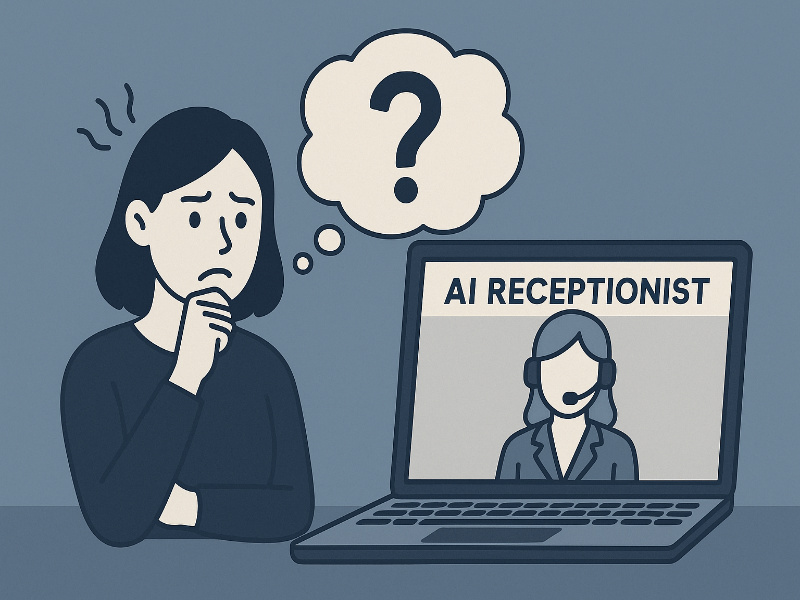Customer resistance to AI receptionists occurs when users prefer human interaction due to concerns about empathy, privacy, communication effectiveness, and fear of technology replacing personal service.
When businesses consider adopting AI-powered receptionists, the first reaction they often hear isn’t excitement—it’s hesitation. Customers fear they’ll be speaking to “robots” instead of humans, that their data won’t be safe, or that they won’t be understood. These fears aren’t irrational; they’re rooted in psychology, past experiences with clunky bots, and deep trust barriers.
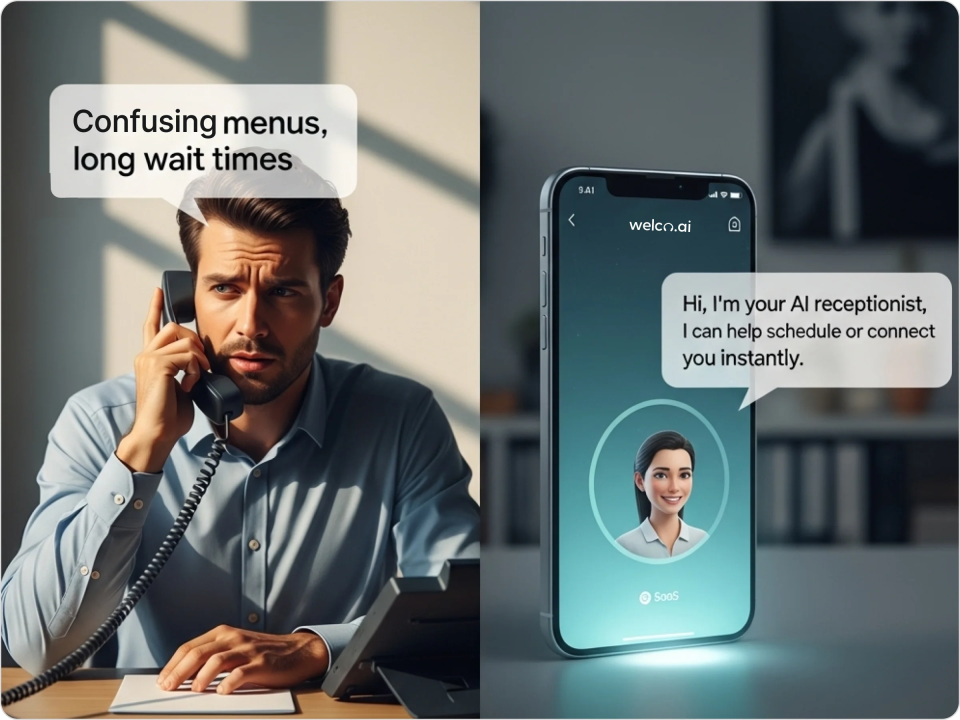
At the same time, AI receptionists offer undeniable advantages: 24/7 availability, lower costs, faster response times, and seamless scheduling. The challenge is not whether AI can technically do the job—it’s whether customers feel comfortable letting it.
Modern AI receptionist platforms focus on helping businesses overcome the psychology of AI resistance with empathy-first design, instant human backup, and transparent communication.
Why do customers psychologically resist AI receptionists?
Most people have tried talking to an outdated bot that loops them in irrelevant menus or refuses to understand their request. This history has built a deep-seated skepticism toward AI in customer-facing roles. According to a 2024 Genesys customer service industry survey, 72% of U.S. customers fear AI will make it harder to reach a human agent. Early AI trained people to expect frustration, not help.
The Cultural and Demographic Factors Competitors Ignore
AI acceptance isn’t uniform. Seniors may see AI as confusing or cold, while younger generations are more comfortable with digital-first interactions. 65% of generative AI users are Millennials or Gen Z , highlighting clear generational divides. In industries like healthcare or law, where empathy and confidentiality are paramount, customers are more resistant than in, say, logistics or retail. Competitors often miss this nuance, rolling out one-size-fits-all solutions without adjusting for cultural or demographic comfort levels.
Real Customer Reactions: Before and After Welco Implementation
Before using modern AI receptionists, SMBs often report customers hanging up when they realize they’re talking to a machine. After implementation with proper transparent scripts and the option to reach a human instantly, those same businesses see fewer dropped calls and higher satisfaction scores.
Common Customer Fears About AI Receptionists (The Complete List)
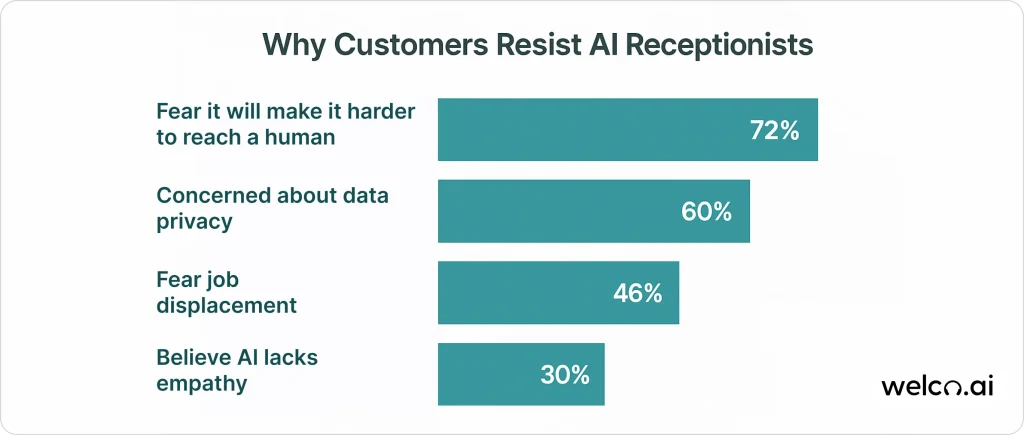
- “I Don’t Want to Talk to a Robot” – The Human Connection Fear
Customers don’t want to feel like just another number. A receptionist is often the first impression of a business, and people expect warmth, empathy, and human nuance. Without these, AI feels impersonal and cold.
- “Will This Replace Real Jobs?” – The Employment Anxiety
Customers, especially in service-driven industries, worry that AI is taking away jobs. 46% cite AI displacing people’s jobs as a top concern. Employees share this fear too, resisting adoption because they see AI as a replacement, not a collaborator.
- “Can It Handle Complex Requests?” – The Capability Doubt
Many fear that AI receptionists won’t understand accents, slang, or complex issues. This is fueled by the “uncanny valley” effect—if an AI sounds too human but then makes mistakes, it creates discomfort and mistrust.
- “Is My Information Safe?” – The Privacy Concern
AI receptionists process sensitive information like addresses, payment details, or medical records. Without clear assurances, customers worry about data breaches and misuse —especially in highly regulated industries like healthcare and law.
How to build customer trust in AI receptionists?
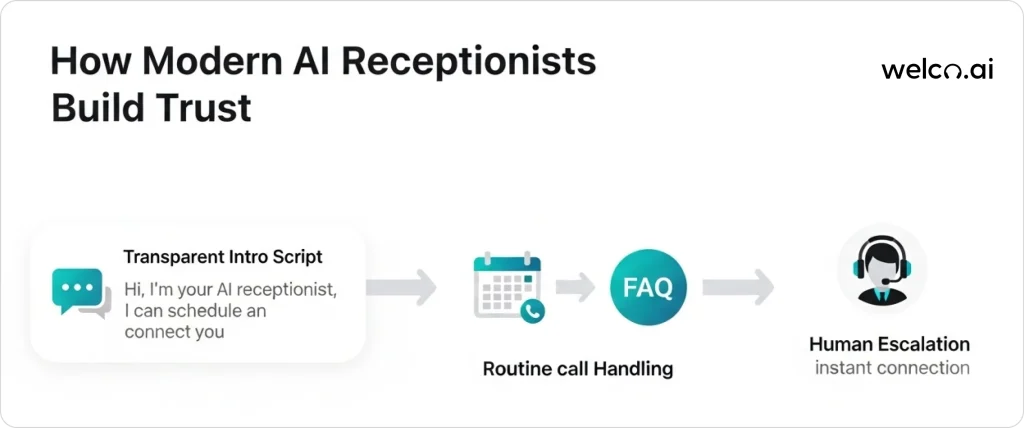
- Transparent Introduction Scripts That Work
Instead of pretending to be human, effective AI receptionists clearly introduce themselves: “Hi, I’m your AI receptionist from Dr. Miller’s office. I can help you schedule, reschedule, or connect you with a staff member right away.” Transparency reduces anxiety and sets accurate expectations.
- The Gradual Implementation Strategy
Unlike enterprise competitors that push full-scale rollouts, modern AI platforms encourage step-by-step adoption. Start with after-hours calls, then expand to overflow calls during peak times. Customers adapt gradually, trust builds, and resistance drops.
- When and How to Escalate to Human Staff
Modern AI platforms always keep the human option open. If a customer says “I want to speak to a person,” the AI instantly escalates.This safety net prevents frustration and shows that AI is an aid, not a gatekeeper.
What strategies overcome customer resistance to AI technology?
- Pre-Launch Customer Education Campaigns
Modern AI platforms provide onboarding scripts and email templates businesses can send before launching AI: “We’re introducing a new AI receptionist to help you reach us faster. Don’t worry—you can always speak to a person anytime you like.” This simple education reduces surprise and builds comfort.
- Staff Training for AI Introduction Conversations
Employees are taught to frame AI as their “assistant,” not their replacement. Example: “Our AI receptionist helps us focus on serving you better while still keeping the human touch whenever you need it.”
- Measuring and Responding to Customer Comfort Levels
Advanced AI dashboards track sentiment (positive/negative calls, escalations) so businesses can see when customers are adjusting or if tweaks are needed.
How to Ease Customer Fears of AI: Real-World Examples
Healthcare Practice Adoption Success
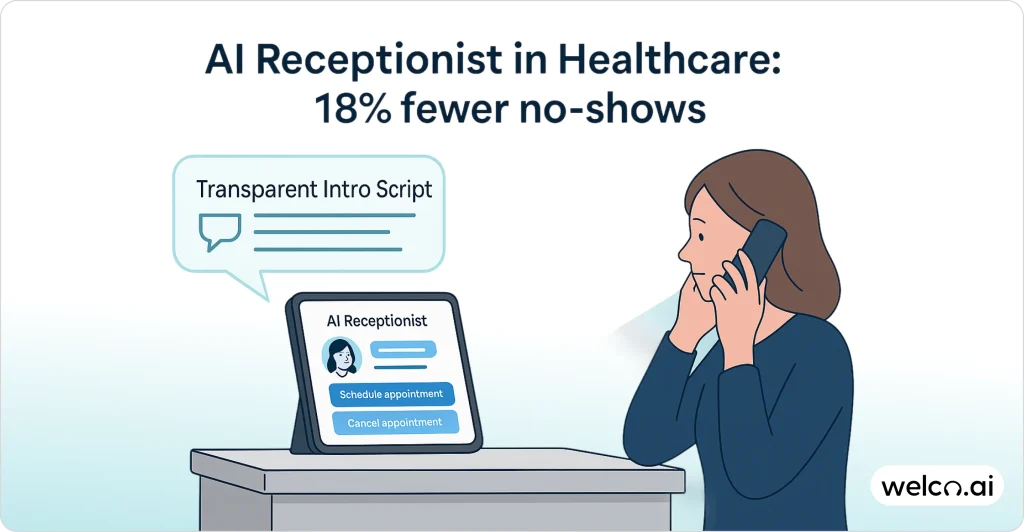
A small medical clinic worried patients would resist talking to an AI. By framing the system as a HIPAA-compliant assistant that only handled scheduling (and instantly routed sensitive matters to staff), patient satisfaction scores increased significantly and no-shows dropped by 18%. Healthcare studies show AI implementation with 60% adoption achieves mean patient satisfaction scores of 8.2 out of 10.
Legal Firm Customer Acceptance Journey
A boutique law firm used AI to filter routine calls (appointments, directions) while guaranteeing immediate human transfer for case-related questions. Clients appreciated faster access and felt reassured by clear disclosure. Legal practices implementing AI reception report 35-45% higher client conversion rates compared to traditional approaches.
Small Business vs Enterprise: Different Approaches
SMBs tend to need quick, low-cost deployments. Modern AI platforms offer 30-minute setup to address that. Enterprises often require phased rollouts across departments; advanced platforms support both, adapting to comfort levels.
Addressing Customer Pushback: What to Say When Customers Resist
- Scripts for Common Objections
“I want to speak to a real person.”
“Of course, let me connect you right away. I’m just here to help when staff are busy.”
- Converting Resistance into Curiosity
When customers hesitate, businesses can frame AI positively: “Think of me as a 24/7 receptionist who makes sure you never wait.”
- When to Offer Alternative Options
If customers remain resistant, businesses can reassure them by offering choices: “You can press 0 at any time to connect with staff.”
AI vs Human Receptionist: The Complete Comparison

Availability and Coverage
- AI: 24/7, no sick days, no vacations
- Human: Limited hours
Cost Analysis with Customer Comfort Factors
- Humans: Come with salaries and benefits
- AI: Reduces cost but adds value only if customers feel comfortable
Quality and Consistency
- Humans: May have off days
- AI: Maintains consistency, but modern platforms blend consistency with empathy cues
Customer Satisfaction Metrics
Across industries, customers rate humans higher initially, but AI satisfaction improves significantly with proper implementation. 77% said that when engaging with customer service, they’d rather interact with a human using AI “in the background” than a fully automated chatbot.
Advanced AI Platform Approaches to Customer Acceptance
30-Minute Setup vs Months-Long Enterprise Implementations
While Salesforce, Genesys, or Microsoft require months of deployment, modern AI platforms are live in under an hour—reducing anxiety for both staff and customer
Psychology-Informed Design Features
From natural conversation design to cultural sensitivity training, modern AI platforms anticipate customer hesitation and adapt interactions accordingly.
Human-AI Collaboration Model
Unlike competitors that push AI as a full replacement, effective platforms position it as an assistant that supports—not replaces—humans. This directly addresses fears of job loss.
Why Customer-Centric AI Wins
The biggest barrier to AI receptionist adoption isn’t technology—it’s psychology. Customers worry about trust, empathy, privacy, and replacement. Competitors like Salesforce or Genesys may offer powerful enterprise features, but they overlook the human side of adoption.
Modern AI platforms are different. With psychology-first design, transparent scripts, instant human backup, and fast, affordable setup, they don’t just answer calls—they build customer confidence.
If you’re ready to overcome customer resistance and deliver 24/7 coverage without losing the human touch, it’s time to explore AI receptionist solutions designed for customer acceptance.cosystems that optimize every aspect of business operations. The businesses investing in this groundwork today are positioning themselves to lead their industries as workplace AI assistance evolves from emerging technology to essential business infrastructure.
Frequently Asked Questions
Why do customers resist AI technology in reception?
Customers often resist AI because they worry it feels impersonal or may not understand their needs. This resistance usually comes from past negative experiences with outdated bots or fear of losing the human touch.
What are the most common concerns about AI receptionists?
The top concerns include data privacy, security, lack of empathy, and whether AI can handle complex requests. 60% fear AI will make it more difficult to reach a live person, followed by AI displacing people’s jobs (46%).
Do people still prefer human receptionists over AI?
Many customers appreciate human receptionists for empathy and nuanced communication. However, research shows growing acceptance of AI receptionists for routine tasks, especially since they offer 24/7 coverage and fast response times.
How can businesses reduce customer resistance to AI receptionists?
The key is transparency, reassurance, and gradual adoption. Businesses can explain how the AI works, highlight security measures, and blend AI with human support to ease customers into the experience.
What helps customers trust AI assistants?
Trust is built through reliability, accuracy, and clear safeguards for data privacy. When customers see AI consistently solving their problems quickly and securely, they begin to view it as a trustworthy solution.
